Detailed Case Study: Customer Satisfaction in UK E-Tourism Industry
VerifiedAdded on 2021/05/30
|65
|10458
|497
Case Study
AI Summary
This case study examines the UK e-tourism industry, focusing on customer behavior and satisfaction. The research aims to identify determinants impacting customer behavior in the UK e-tourism sector. The study explores the impact of ICT on the tourism industry and e-tourism's evolution. It investigates the relationship between service quality, customer satisfaction, and other factors. The methodology includes a literature review, research philosophy, approach, strategy, design, variable definitions, sample selection, data collection methods, analytical procedures, and ethical considerations. Findings are presented through tables and figures, analyzing factors like nationality, gender, age, education, income, holiday frequency, and service satisfaction. The study concludes with recommendations for enhancing customer satisfaction within the e-tourism industry, offering valuable insights for industry stakeholders.
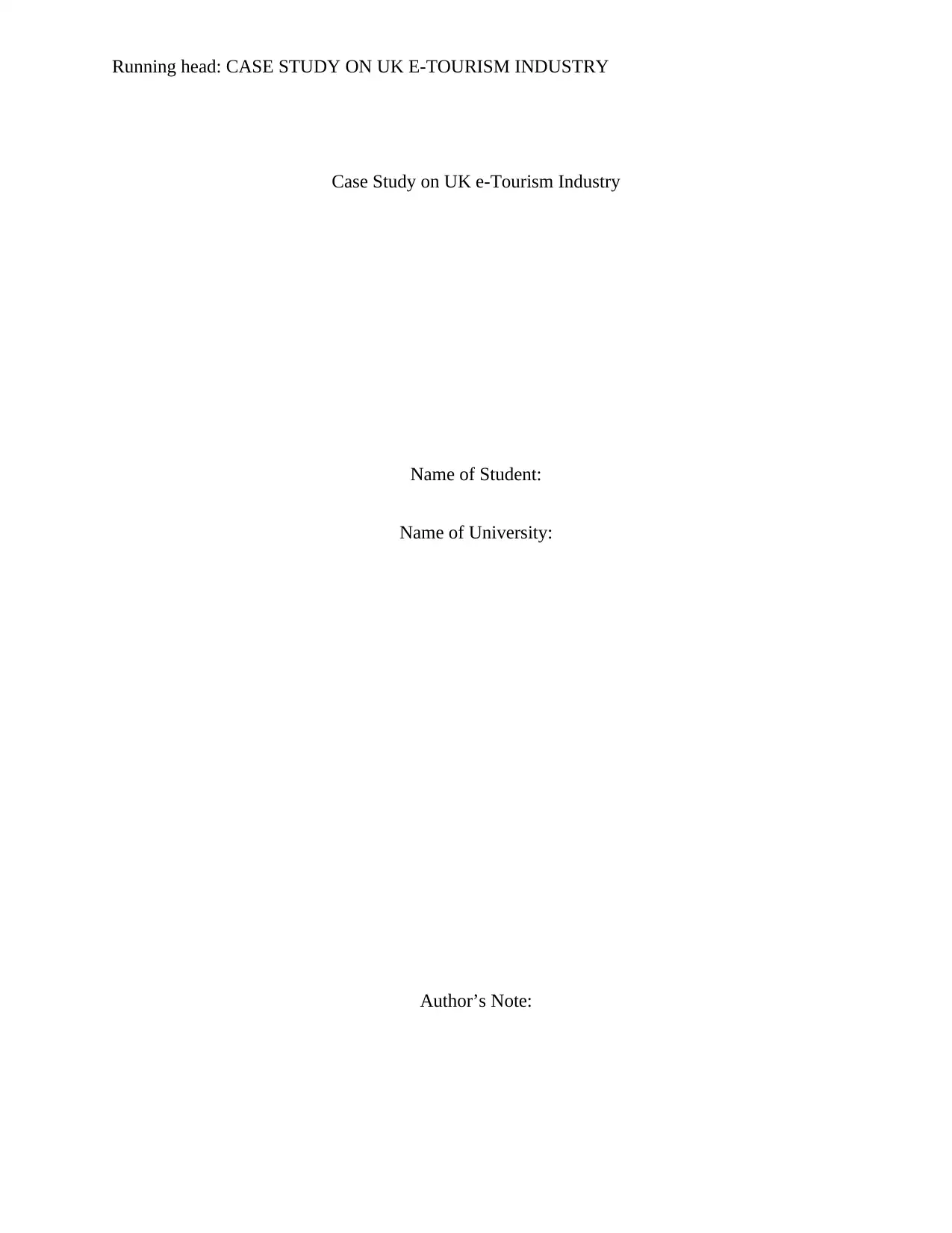
Running head: CASE STUDY ON UK E-TOURISM INDUSTRY
Case Study on UK e-Tourism Industry
Name of Student:
Name of University:
Author’s Note:
Case Study on UK e-Tourism Industry
Name of Student:
Name of University:
Author’s Note:
Paraphrase This Document
Need a fresh take? Get an instant paraphrase of this document with our AI Paraphraser
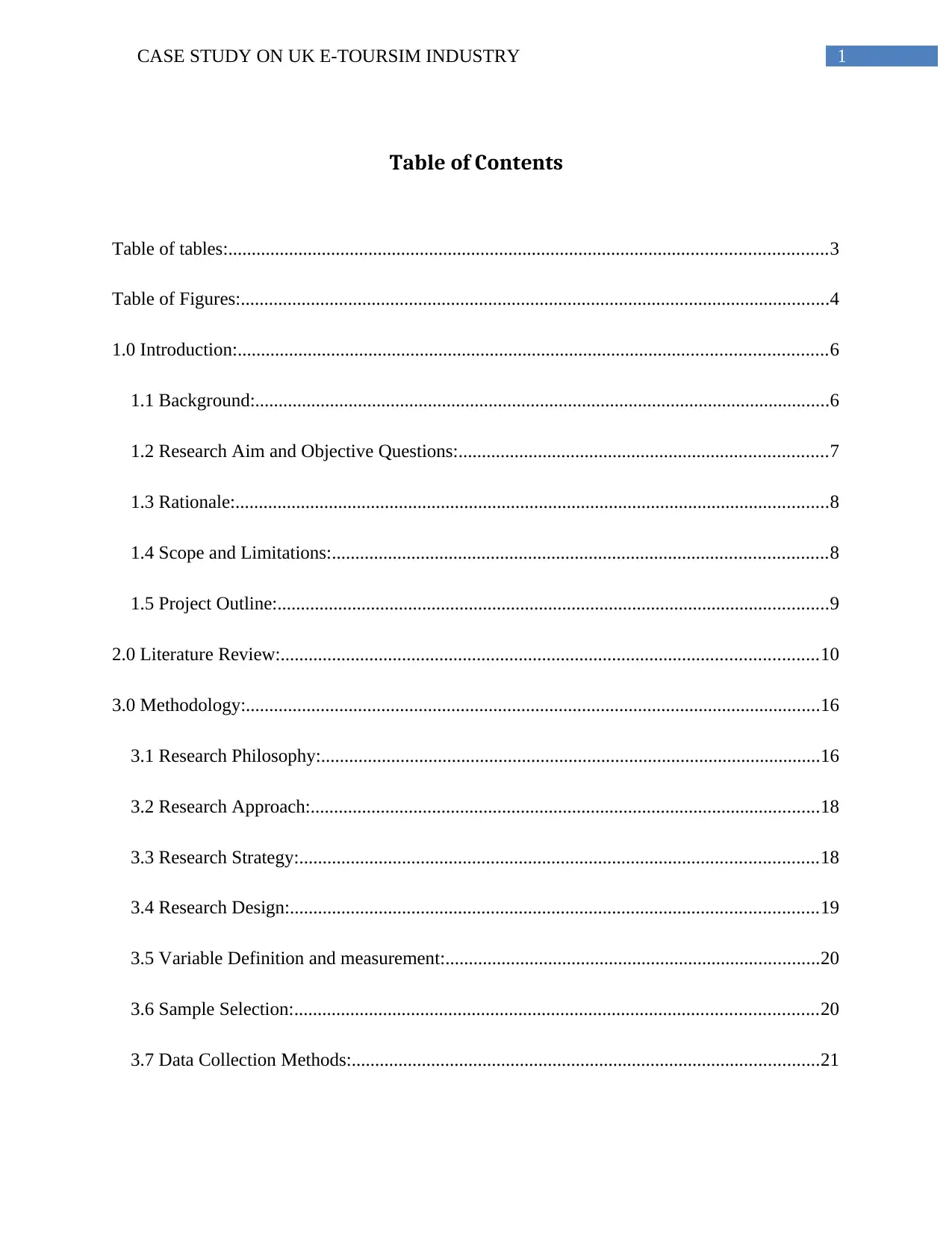
1CASE STUDY ON UK E-TOURSIM INDUSTRY
Table of Contents
Table of tables:................................................................................................................................3
Table of Figures:..............................................................................................................................4
1.0 Introduction:..............................................................................................................................6
1.1 Background:...........................................................................................................................6
1.2 Research Aim and Objective Questions:...............................................................................7
1.3 Rationale:...............................................................................................................................8
1.4 Scope and Limitations:..........................................................................................................8
1.5 Project Outline:......................................................................................................................9
2.0 Literature Review:...................................................................................................................10
3.0 Methodology:...........................................................................................................................16
3.1 Research Philosophy:...........................................................................................................16
3.2 Research Approach:.............................................................................................................18
3.3 Research Strategy:...............................................................................................................18
3.4 Research Design:.................................................................................................................19
3.5 Variable Definition and measurement:................................................................................20
3.6 Sample Selection:................................................................................................................20
3.7 Data Collection Methods:....................................................................................................21
Table of Contents
Table of tables:................................................................................................................................3
Table of Figures:..............................................................................................................................4
1.0 Introduction:..............................................................................................................................6
1.1 Background:...........................................................................................................................6
1.2 Research Aim and Objective Questions:...............................................................................7
1.3 Rationale:...............................................................................................................................8
1.4 Scope and Limitations:..........................................................................................................8
1.5 Project Outline:......................................................................................................................9
2.0 Literature Review:...................................................................................................................10
3.0 Methodology:...........................................................................................................................16
3.1 Research Philosophy:...........................................................................................................16
3.2 Research Approach:.............................................................................................................18
3.3 Research Strategy:...............................................................................................................18
3.4 Research Design:.................................................................................................................19
3.5 Variable Definition and measurement:................................................................................20
3.6 Sample Selection:................................................................................................................20
3.7 Data Collection Methods:....................................................................................................21
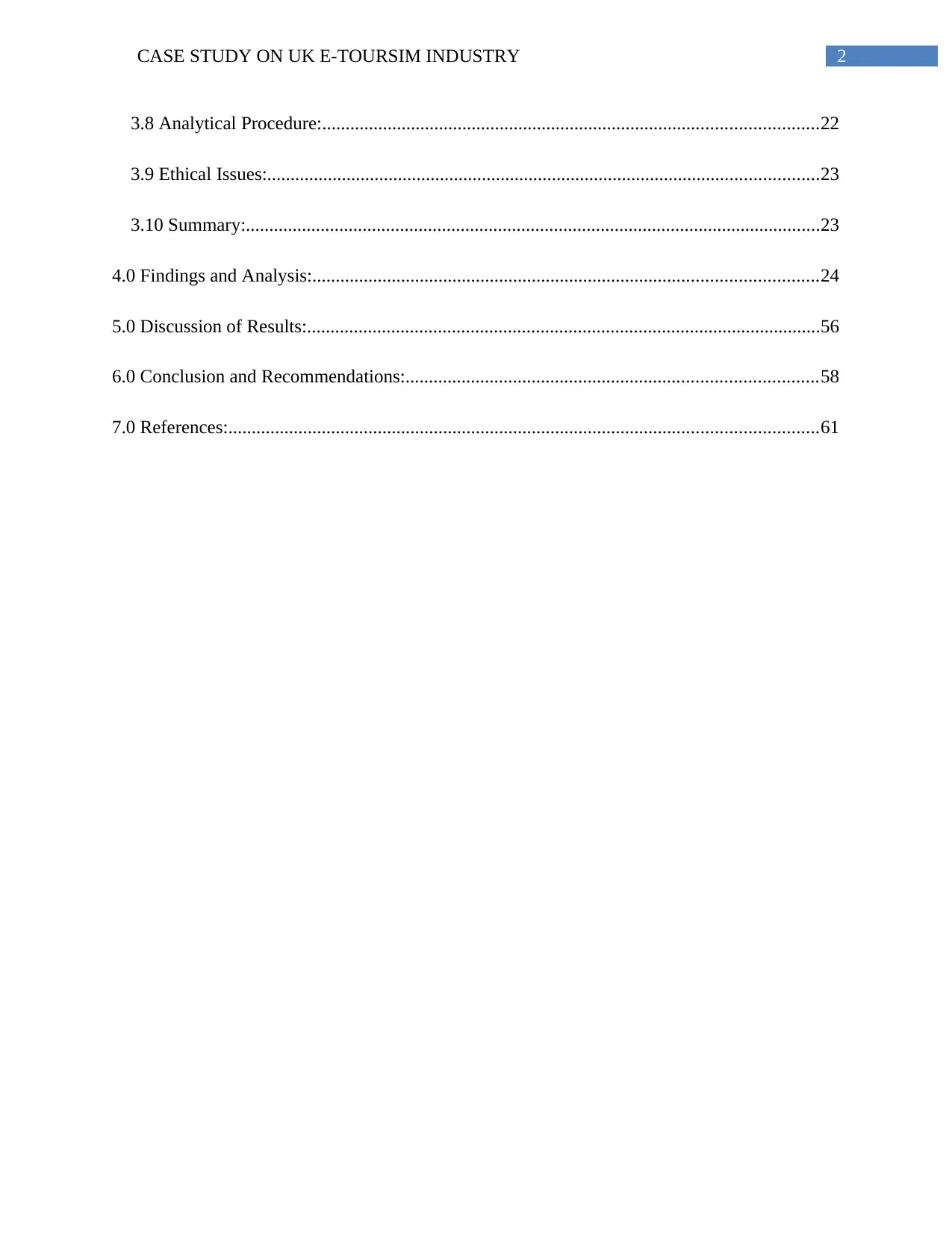
2CASE STUDY ON UK E-TOURSIM INDUSTRY
3.8 Analytical Procedure:..........................................................................................................22
3.9 Ethical Issues:......................................................................................................................23
3.10 Summary:...........................................................................................................................23
4.0 Findings and Analysis:............................................................................................................24
5.0 Discussion of Results:..............................................................................................................56
6.0 Conclusion and Recommendations:........................................................................................58
7.0 References:..............................................................................................................................61
3.8 Analytical Procedure:..........................................................................................................22
3.9 Ethical Issues:......................................................................................................................23
3.10 Summary:...........................................................................................................................23
4.0 Findings and Analysis:............................................................................................................24
5.0 Discussion of Results:..............................................................................................................56
6.0 Conclusion and Recommendations:........................................................................................58
7.0 References:..............................................................................................................................61
⊘ This is a preview!⊘
Do you want full access?
Subscribe today to unlock all pages.

Trusted by 1+ million students worldwide
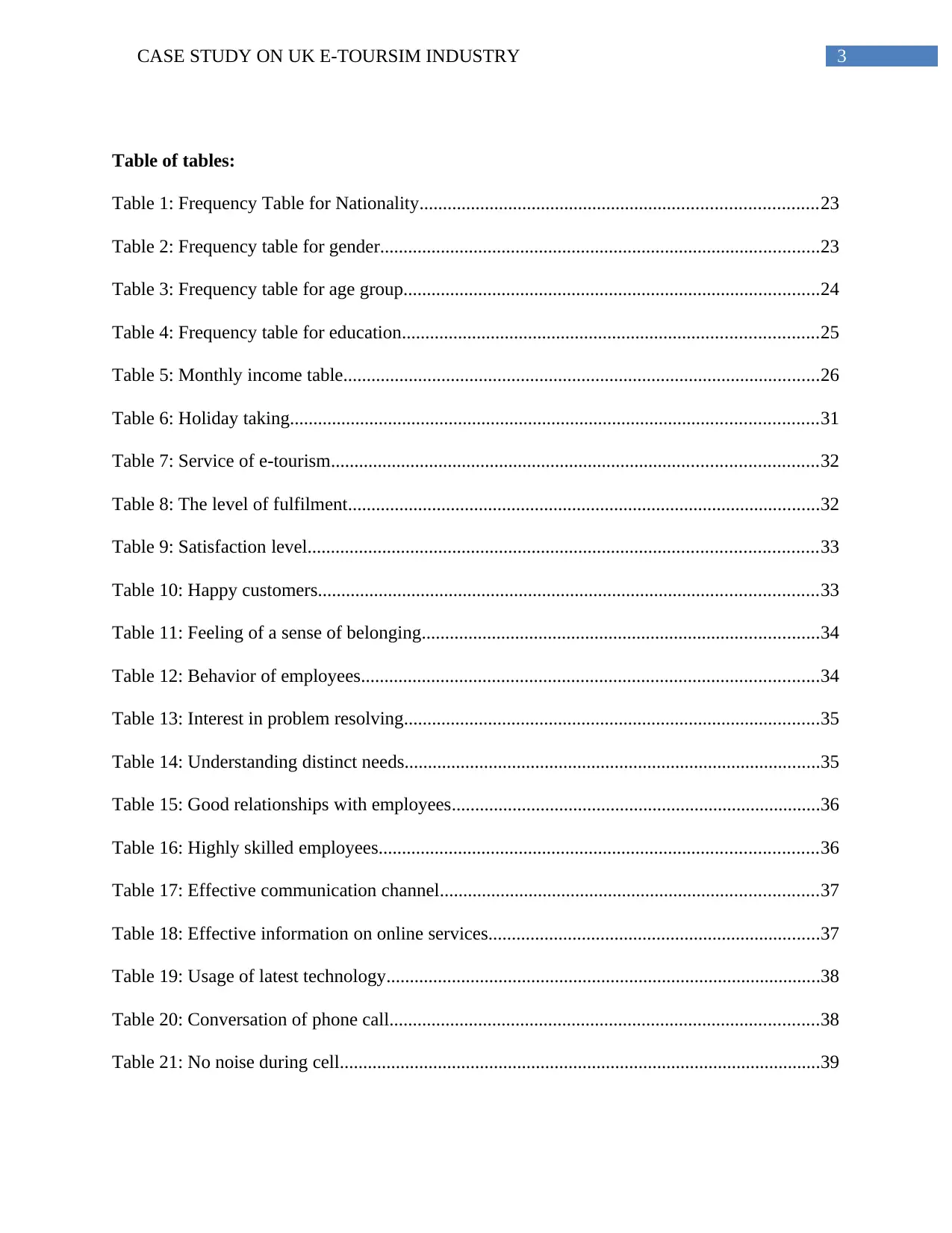
3CASE STUDY ON UK E-TOURSIM INDUSTRY
Table of tables:
Table 1: Frequency Table for Nationality.....................................................................................23
Table 2: Frequency table for gender..............................................................................................23
Table 3: Frequency table for age group.........................................................................................24
Table 4: Frequency table for education.........................................................................................25
Table 5: Monthly income table......................................................................................................26
Table 6: Holiday taking.................................................................................................................31
Table 7: Service of e-tourism........................................................................................................32
Table 8: The level of fulfilment.....................................................................................................32
Table 9: Satisfaction level.............................................................................................................33
Table 10: Happy customers...........................................................................................................33
Table 11: Feeling of a sense of belonging.....................................................................................34
Table 12: Behavior of employees..................................................................................................34
Table 13: Interest in problem resolving.........................................................................................35
Table 14: Understanding distinct needs.........................................................................................35
Table 15: Good relationships with employees...............................................................................36
Table 16: Highly skilled employees..............................................................................................36
Table 17: Effective communication channel.................................................................................37
Table 18: Effective information on online services.......................................................................37
Table 19: Usage of latest technology.............................................................................................38
Table 20: Conversation of phone call............................................................................................38
Table 21: No noise during cell.......................................................................................................39
Table of tables:
Table 1: Frequency Table for Nationality.....................................................................................23
Table 2: Frequency table for gender..............................................................................................23
Table 3: Frequency table for age group.........................................................................................24
Table 4: Frequency table for education.........................................................................................25
Table 5: Monthly income table......................................................................................................26
Table 6: Holiday taking.................................................................................................................31
Table 7: Service of e-tourism........................................................................................................32
Table 8: The level of fulfilment.....................................................................................................32
Table 9: Satisfaction level.............................................................................................................33
Table 10: Happy customers...........................................................................................................33
Table 11: Feeling of a sense of belonging.....................................................................................34
Table 12: Behavior of employees..................................................................................................34
Table 13: Interest in problem resolving.........................................................................................35
Table 14: Understanding distinct needs.........................................................................................35
Table 15: Good relationships with employees...............................................................................36
Table 16: Highly skilled employees..............................................................................................36
Table 17: Effective communication channel.................................................................................37
Table 18: Effective information on online services.......................................................................37
Table 19: Usage of latest technology.............................................................................................38
Table 20: Conversation of phone call............................................................................................38
Table 21: No noise during cell.......................................................................................................39
Paraphrase This Document
Need a fresh take? Get an instant paraphrase of this document with our AI Paraphraser
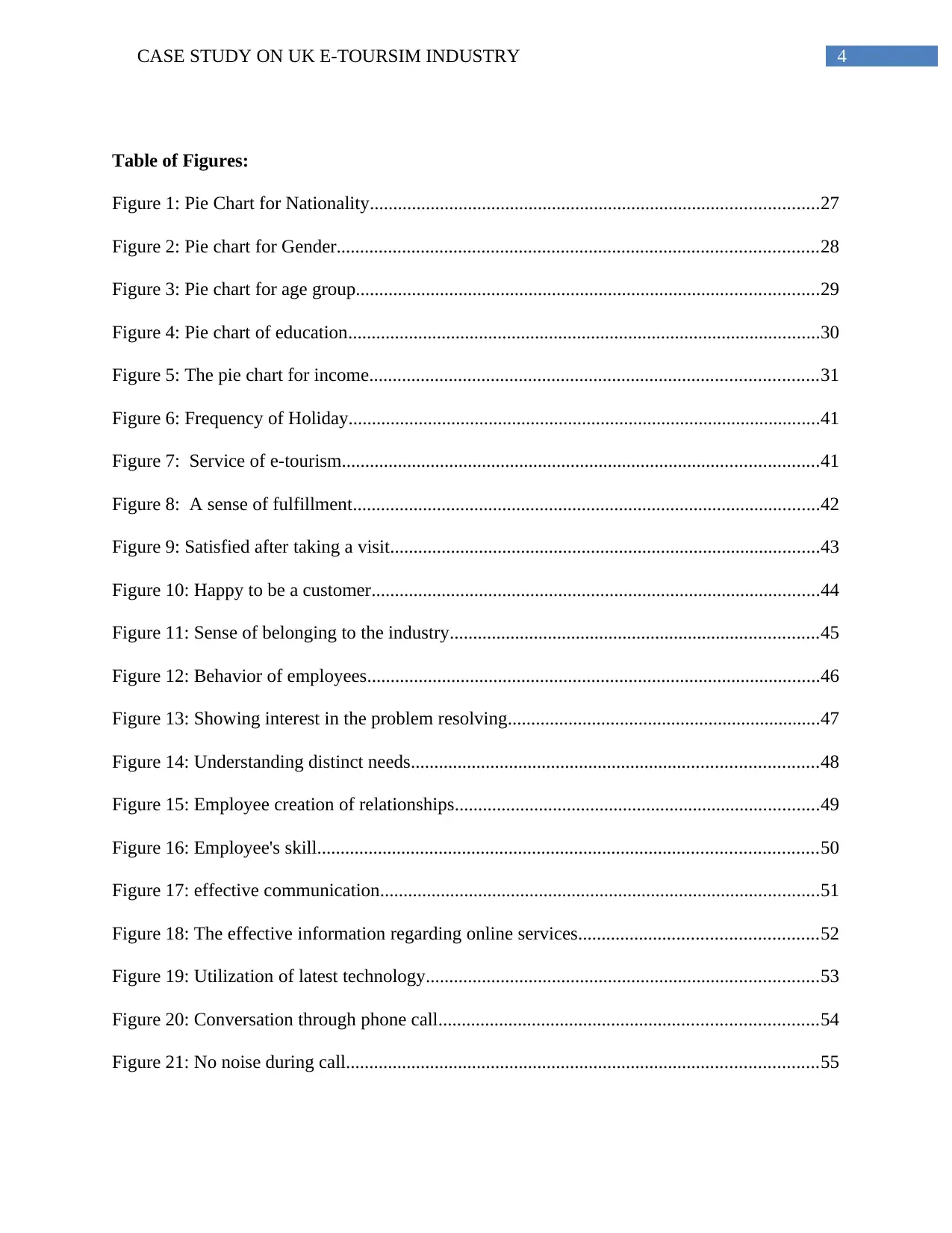
4CASE STUDY ON UK E-TOURSIM INDUSTRY
Table of Figures:
Figure 1: Pie Chart for Nationality................................................................................................27
Figure 2: Pie chart for Gender.......................................................................................................28
Figure 3: Pie chart for age group...................................................................................................29
Figure 4: Pie chart of education.....................................................................................................30
Figure 5: The pie chart for income................................................................................................31
Figure 6: Frequency of Holiday.....................................................................................................41
Figure 7: Service of e-tourism......................................................................................................41
Figure 8: A sense of fulfillment....................................................................................................42
Figure 9: Satisfied after taking a visit............................................................................................43
Figure 10: Happy to be a customer................................................................................................44
Figure 11: Sense of belonging to the industry...............................................................................45
Figure 12: Behavior of employees.................................................................................................46
Figure 13: Showing interest in the problem resolving...................................................................47
Figure 14: Understanding distinct needs.......................................................................................48
Figure 15: Employee creation of relationships..............................................................................49
Figure 16: Employee's skill...........................................................................................................50
Figure 17: effective communication..............................................................................................51
Figure 18: The effective information regarding online services...................................................52
Figure 19: Utilization of latest technology....................................................................................53
Figure 20: Conversation through phone call.................................................................................54
Figure 21: No noise during call.....................................................................................................55
Table of Figures:
Figure 1: Pie Chart for Nationality................................................................................................27
Figure 2: Pie chart for Gender.......................................................................................................28
Figure 3: Pie chart for age group...................................................................................................29
Figure 4: Pie chart of education.....................................................................................................30
Figure 5: The pie chart for income................................................................................................31
Figure 6: Frequency of Holiday.....................................................................................................41
Figure 7: Service of e-tourism......................................................................................................41
Figure 8: A sense of fulfillment....................................................................................................42
Figure 9: Satisfied after taking a visit............................................................................................43
Figure 10: Happy to be a customer................................................................................................44
Figure 11: Sense of belonging to the industry...............................................................................45
Figure 12: Behavior of employees.................................................................................................46
Figure 13: Showing interest in the problem resolving...................................................................47
Figure 14: Understanding distinct needs.......................................................................................48
Figure 15: Employee creation of relationships..............................................................................49
Figure 16: Employee's skill...........................................................................................................50
Figure 17: effective communication..............................................................................................51
Figure 18: The effective information regarding online services...................................................52
Figure 19: Utilization of latest technology....................................................................................53
Figure 20: Conversation through phone call.................................................................................54
Figure 21: No noise during call.....................................................................................................55

5CASE STUDY ON UK E-TOURSIM INDUSTRY
⊘ This is a preview!⊘
Do you want full access?
Subscribe today to unlock all pages.

Trusted by 1+ million students worldwide
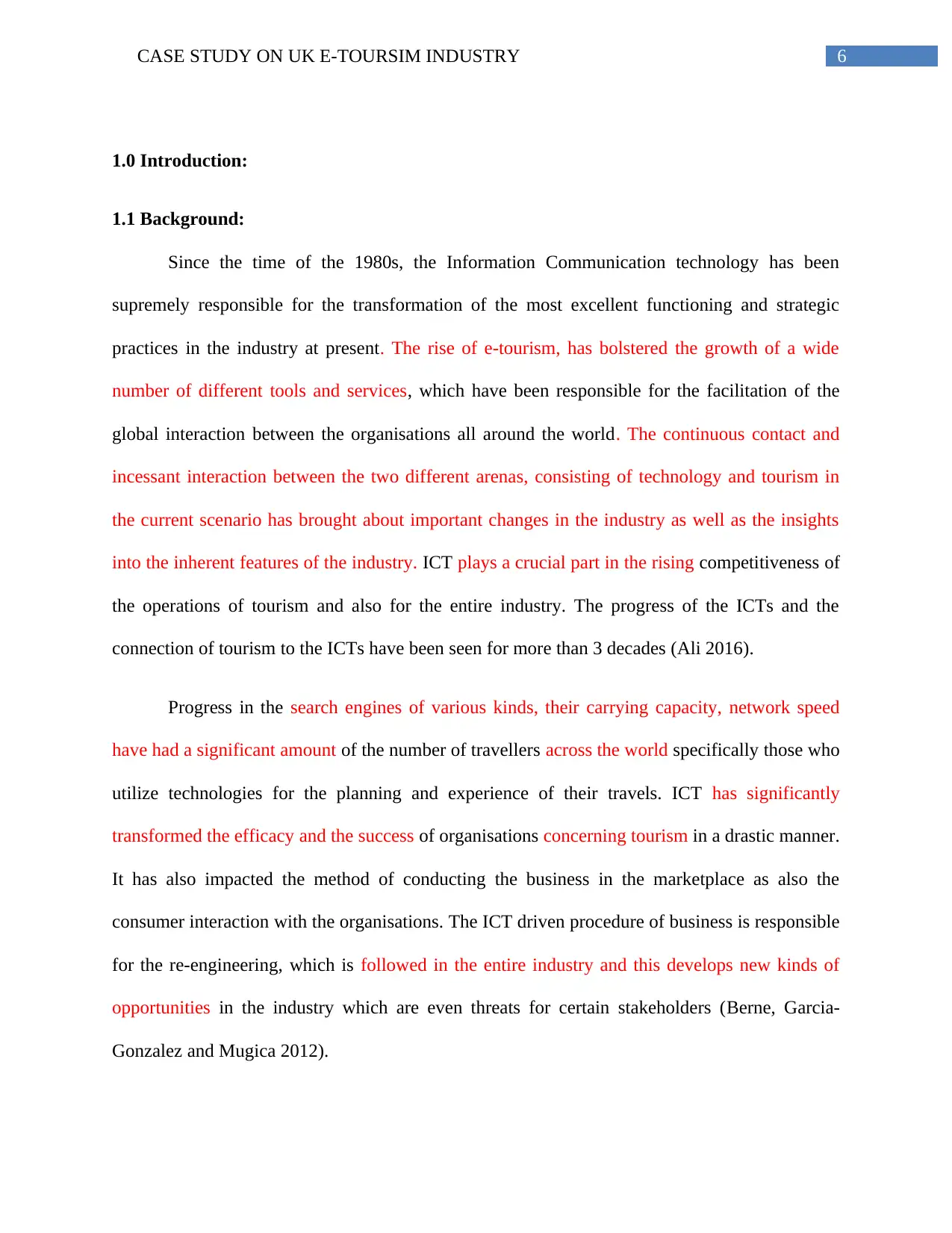
6CASE STUDY ON UK E-TOURSIM INDUSTRY
1.0 Introduction:
1.1 Background:
Since the time of the 1980s, the Information Communication technology has been
supremely responsible for the transformation of the most excellent functioning and strategic
practices in the industry at present. The rise of e-tourism, has bolstered the growth of a wide
number of different tools and services, which have been responsible for the facilitation of the
global interaction between the organisations all around the world. The continuous contact and
incessant interaction between the two different arenas, consisting of technology and tourism in
the current scenario has brought about important changes in the industry as well as the insights
into the inherent features of the industry. ICT plays a crucial part in the rising competitiveness of
the operations of tourism and also for the entire industry. The progress of the ICTs and the
connection of tourism to the ICTs have been seen for more than 3 decades (Ali 2016).
Progress in the search engines of various kinds, their carrying capacity, network speed
have had a significant amount of the number of travellers across the world specifically those who
utilize technologies for the planning and experience of their travels. ICT has significantly
transformed the efficacy and the success of organisations concerning tourism in a drastic manner.
It has also impacted the method of conducting the business in the marketplace as also the
consumer interaction with the organisations. The ICT driven procedure of business is responsible
for the re-engineering, which is followed in the entire industry and this develops new kinds of
opportunities in the industry which are even threats for certain stakeholders (Berne, Garcia-
Gonzalez and Mugica 2012).
1.0 Introduction:
1.1 Background:
Since the time of the 1980s, the Information Communication technology has been
supremely responsible for the transformation of the most excellent functioning and strategic
practices in the industry at present. The rise of e-tourism, has bolstered the growth of a wide
number of different tools and services, which have been responsible for the facilitation of the
global interaction between the organisations all around the world. The continuous contact and
incessant interaction between the two different arenas, consisting of technology and tourism in
the current scenario has brought about important changes in the industry as well as the insights
into the inherent features of the industry. ICT plays a crucial part in the rising competitiveness of
the operations of tourism and also for the entire industry. The progress of the ICTs and the
connection of tourism to the ICTs have been seen for more than 3 decades (Ali 2016).
Progress in the search engines of various kinds, their carrying capacity, network speed
have had a significant amount of the number of travellers across the world specifically those who
utilize technologies for the planning and experience of their travels. ICT has significantly
transformed the efficacy and the success of organisations concerning tourism in a drastic manner.
It has also impacted the method of conducting the business in the marketplace as also the
consumer interaction with the organisations. The ICT driven procedure of business is responsible
for the re-engineering, which is followed in the entire industry and this develops new kinds of
opportunities in the industry which are even threats for certain stakeholders (Berne, Garcia-
Gonzalez and Mugica 2012).
Paraphrase This Document
Need a fresh take? Get an instant paraphrase of this document with our AI Paraphraser
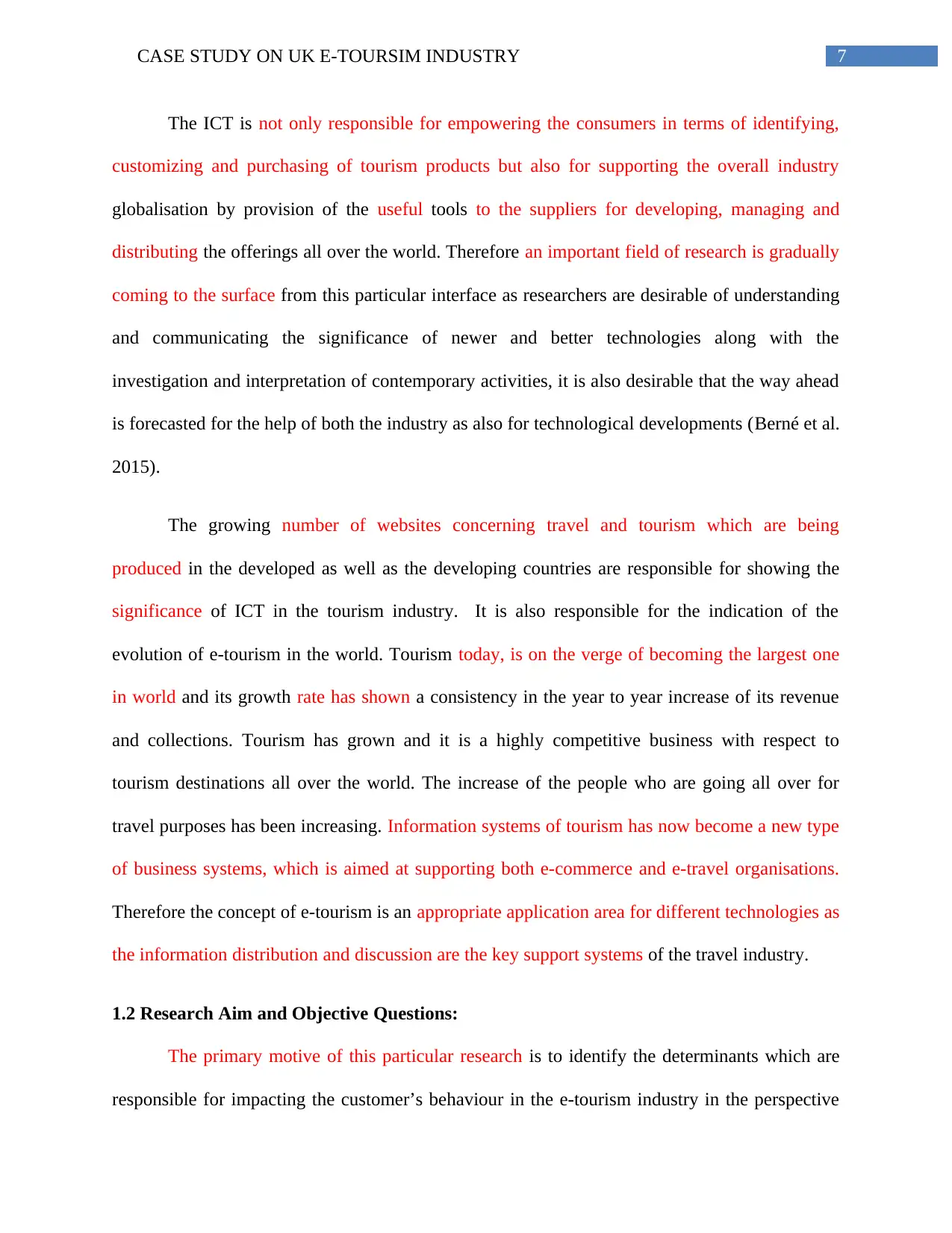
7CASE STUDY ON UK E-TOURSIM INDUSTRY
The ICT is not only responsible for empowering the consumers in terms of identifying,
customizing and purchasing of tourism products but also for supporting the overall industry
globalisation by provision of the useful tools to the suppliers for developing, managing and
distributing the offerings all over the world. Therefore an important field of research is gradually
coming to the surface from this particular interface as researchers are desirable of understanding
and communicating the significance of newer and better technologies along with the
investigation and interpretation of contemporary activities, it is also desirable that the way ahead
is forecasted for the help of both the industry as also for technological developments (Berné et al.
2015).
The growing number of websites concerning travel and tourism which are being
produced in the developed as well as the developing countries are responsible for showing the
significance of ICT in the tourism industry. It is also responsible for the indication of the
evolution of e-tourism in the world. Tourism today, is on the verge of becoming the largest one
in world and its growth rate has shown a consistency in the year to year increase of its revenue
and collections. Tourism has grown and it is a highly competitive business with respect to
tourism destinations all over the world. The increase of the people who are going all over for
travel purposes has been increasing. Information systems of tourism has now become a new type
of business systems, which is aimed at supporting both e-commerce and e-travel organisations.
Therefore the concept of e-tourism is an appropriate application area for different technologies as
the information distribution and discussion are the key support systems of the travel industry.
1.2 Research Aim and Objective Questions:
The primary motive of this particular research is to identify the determinants which are
responsible for impacting the customer’s behaviour in the e-tourism industry in the perspective
The ICT is not only responsible for empowering the consumers in terms of identifying,
customizing and purchasing of tourism products but also for supporting the overall industry
globalisation by provision of the useful tools to the suppliers for developing, managing and
distributing the offerings all over the world. Therefore an important field of research is gradually
coming to the surface from this particular interface as researchers are desirable of understanding
and communicating the significance of newer and better technologies along with the
investigation and interpretation of contemporary activities, it is also desirable that the way ahead
is forecasted for the help of both the industry as also for technological developments (Berné et al.
2015).
The growing number of websites concerning travel and tourism which are being
produced in the developed as well as the developing countries are responsible for showing the
significance of ICT in the tourism industry. It is also responsible for the indication of the
evolution of e-tourism in the world. Tourism today, is on the verge of becoming the largest one
in world and its growth rate has shown a consistency in the year to year increase of its revenue
and collections. Tourism has grown and it is a highly competitive business with respect to
tourism destinations all over the world. The increase of the people who are going all over for
travel purposes has been increasing. Information systems of tourism has now become a new type
of business systems, which is aimed at supporting both e-commerce and e-travel organisations.
Therefore the concept of e-tourism is an appropriate application area for different technologies as
the information distribution and discussion are the key support systems of the travel industry.
1.2 Research Aim and Objective Questions:
The primary motive of this particular research is to identify the determinants which are
responsible for impacting the customer’s behaviour in the e-tourism industry in the perspective
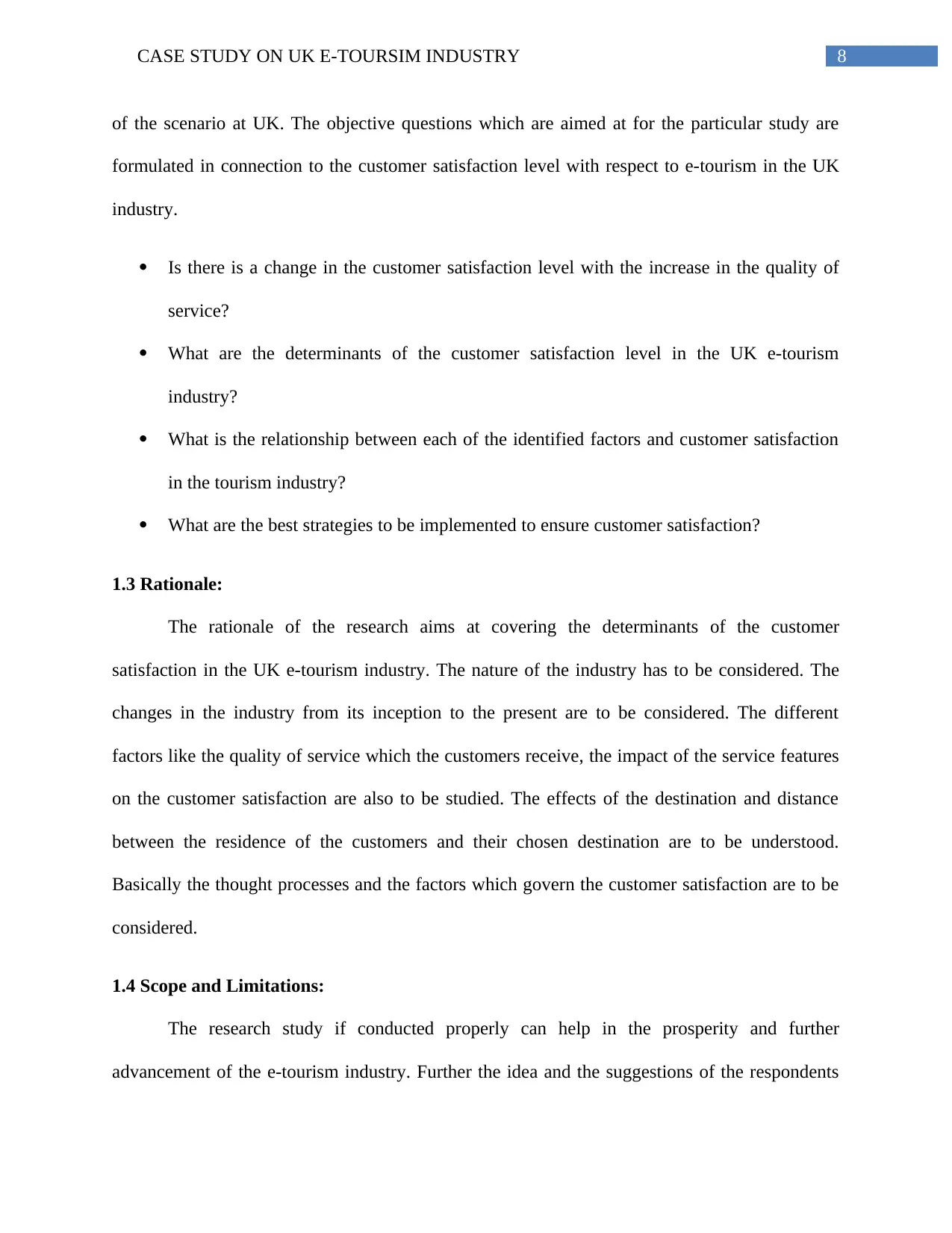
8CASE STUDY ON UK E-TOURSIM INDUSTRY
of the scenario at UK. The objective questions which are aimed at for the particular study are
formulated in connection to the customer satisfaction level with respect to e-tourism in the UK
industry.
Is there is a change in the customer satisfaction level with the increase in the quality of
service?
What are the determinants of the customer satisfaction level in the UK e-tourism
industry?
What is the relationship between each of the identified factors and customer satisfaction
in the tourism industry?
What are the best strategies to be implemented to ensure customer satisfaction?
1.3 Rationale:
The rationale of the research aims at covering the determinants of the customer
satisfaction in the UK e-tourism industry. The nature of the industry has to be considered. The
changes in the industry from its inception to the present are to be considered. The different
factors like the quality of service which the customers receive, the impact of the service features
on the customer satisfaction are also to be studied. The effects of the destination and distance
between the residence of the customers and their chosen destination are to be understood.
Basically the thought processes and the factors which govern the customer satisfaction are to be
considered.
1.4 Scope and Limitations:
The research study if conducted properly can help in the prosperity and further
advancement of the e-tourism industry. Further the idea and the suggestions of the respondents
of the scenario at UK. The objective questions which are aimed at for the particular study are
formulated in connection to the customer satisfaction level with respect to e-tourism in the UK
industry.
Is there is a change in the customer satisfaction level with the increase in the quality of
service?
What are the determinants of the customer satisfaction level in the UK e-tourism
industry?
What is the relationship between each of the identified factors and customer satisfaction
in the tourism industry?
What are the best strategies to be implemented to ensure customer satisfaction?
1.3 Rationale:
The rationale of the research aims at covering the determinants of the customer
satisfaction in the UK e-tourism industry. The nature of the industry has to be considered. The
changes in the industry from its inception to the present are to be considered. The different
factors like the quality of service which the customers receive, the impact of the service features
on the customer satisfaction are also to be studied. The effects of the destination and distance
between the residence of the customers and their chosen destination are to be understood.
Basically the thought processes and the factors which govern the customer satisfaction are to be
considered.
1.4 Scope and Limitations:
The research study if conducted properly can help in the prosperity and further
advancement of the e-tourism industry. Further the idea and the suggestions of the respondents
⊘ This is a preview!⊘
Do you want full access?
Subscribe today to unlock all pages.

Trusted by 1+ million students worldwide
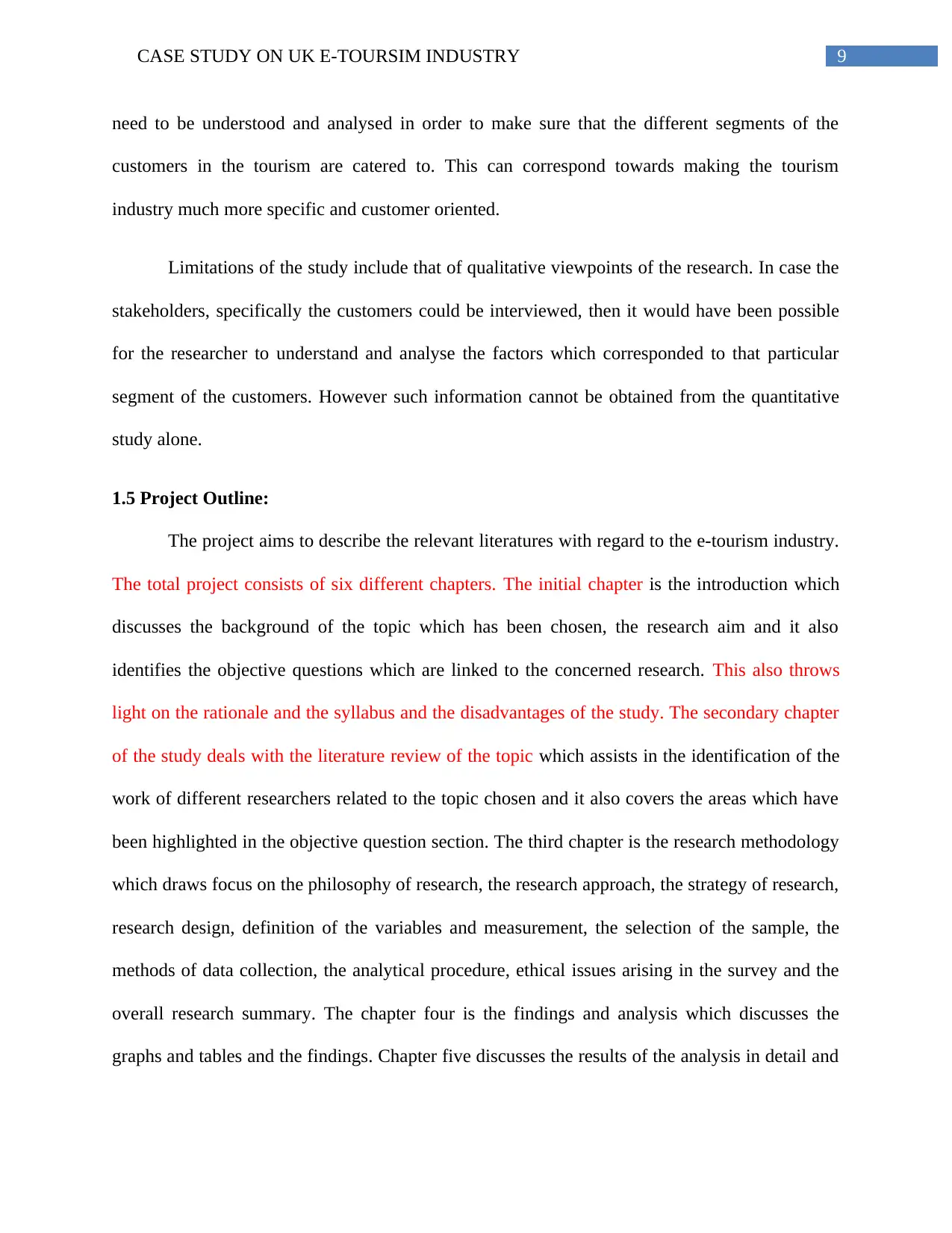
9CASE STUDY ON UK E-TOURSIM INDUSTRY
need to be understood and analysed in order to make sure that the different segments of the
customers in the tourism are catered to. This can correspond towards making the tourism
industry much more specific and customer oriented.
Limitations of the study include that of qualitative viewpoints of the research. In case the
stakeholders, specifically the customers could be interviewed, then it would have been possible
for the researcher to understand and analyse the factors which corresponded to that particular
segment of the customers. However such information cannot be obtained from the quantitative
study alone.
1.5 Project Outline:
The project aims to describe the relevant literatures with regard to the e-tourism industry.
The total project consists of six different chapters. The initial chapter is the introduction which
discusses the background of the topic which has been chosen, the research aim and it also
identifies the objective questions which are linked to the concerned research. This also throws
light on the rationale and the syllabus and the disadvantages of the study. The secondary chapter
of the study deals with the literature review of the topic which assists in the identification of the
work of different researchers related to the topic chosen and it also covers the areas which have
been highlighted in the objective question section. The third chapter is the research methodology
which draws focus on the philosophy of research, the research approach, the strategy of research,
research design, definition of the variables and measurement, the selection of the sample, the
methods of data collection, the analytical procedure, ethical issues arising in the survey and the
overall research summary. The chapter four is the findings and analysis which discusses the
graphs and tables and the findings. Chapter five discusses the results of the analysis in detail and
need to be understood and analysed in order to make sure that the different segments of the
customers in the tourism are catered to. This can correspond towards making the tourism
industry much more specific and customer oriented.
Limitations of the study include that of qualitative viewpoints of the research. In case the
stakeholders, specifically the customers could be interviewed, then it would have been possible
for the researcher to understand and analyse the factors which corresponded to that particular
segment of the customers. However such information cannot be obtained from the quantitative
study alone.
1.5 Project Outline:
The project aims to describe the relevant literatures with regard to the e-tourism industry.
The total project consists of six different chapters. The initial chapter is the introduction which
discusses the background of the topic which has been chosen, the research aim and it also
identifies the objective questions which are linked to the concerned research. This also throws
light on the rationale and the syllabus and the disadvantages of the study. The secondary chapter
of the study deals with the literature review of the topic which assists in the identification of the
work of different researchers related to the topic chosen and it also covers the areas which have
been highlighted in the objective question section. The third chapter is the research methodology
which draws focus on the philosophy of research, the research approach, the strategy of research,
research design, definition of the variables and measurement, the selection of the sample, the
methods of data collection, the analytical procedure, ethical issues arising in the survey and the
overall research summary. The chapter four is the findings and analysis which discusses the
graphs and tables and the findings. Chapter five discusses the results of the analysis in detail and
Paraphrase This Document
Need a fresh take? Get an instant paraphrase of this document with our AI Paraphraser
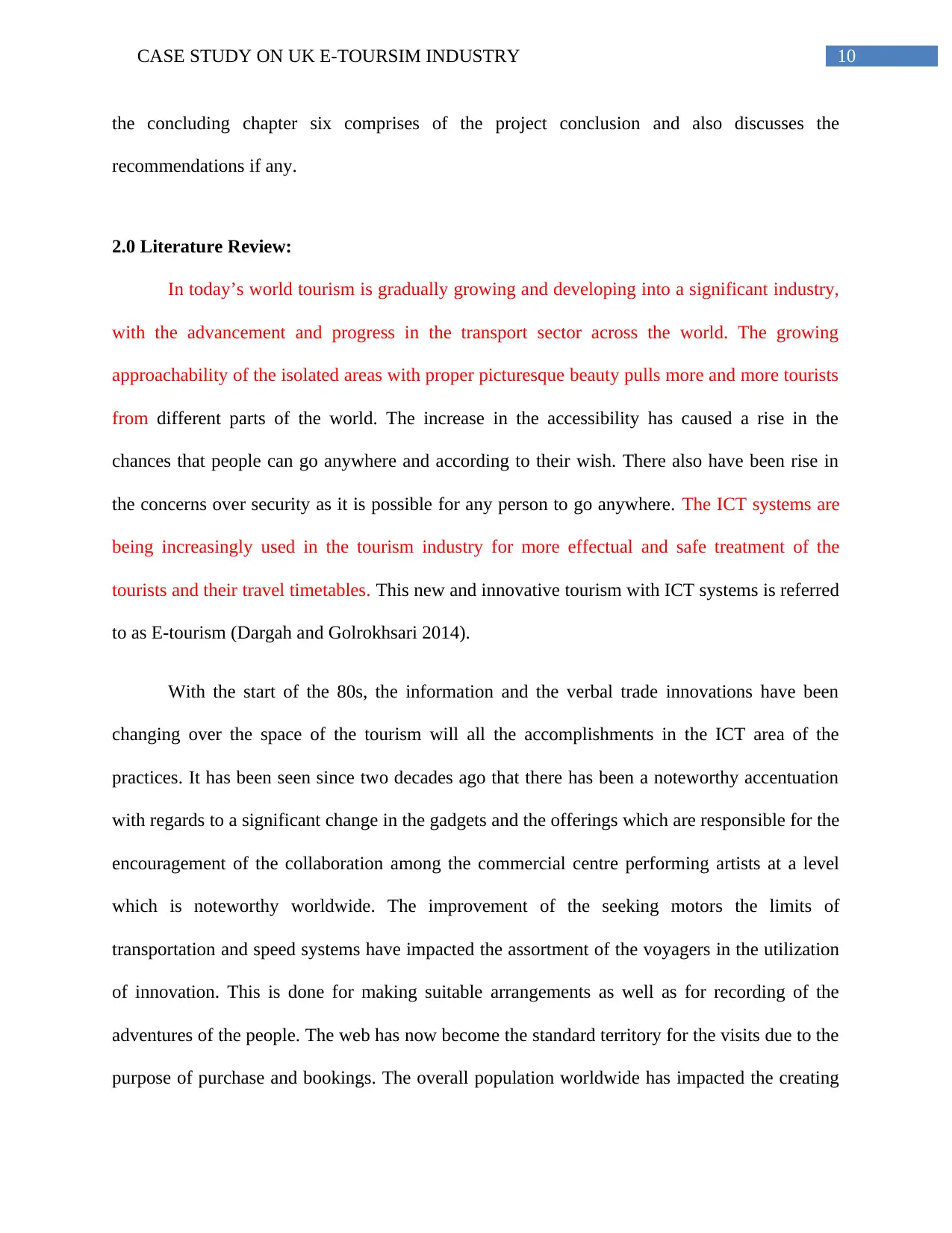
10CASE STUDY ON UK E-TOURSIM INDUSTRY
the concluding chapter six comprises of the project conclusion and also discusses the
recommendations if any.
2.0 Literature Review:
In today’s world tourism is gradually growing and developing into a significant industry,
with the advancement and progress in the transport sector across the world. The growing
approachability of the isolated areas with proper picturesque beauty pulls more and more tourists
from different parts of the world. The increase in the accessibility has caused a rise in the
chances that people can go anywhere and according to their wish. There also have been rise in
the concerns over security as it is possible for any person to go anywhere. The ICT systems are
being increasingly used in the tourism industry for more effectual and safe treatment of the
tourists and their travel timetables. This new and innovative tourism with ICT systems is referred
to as E-tourism (Dargah and Golrokhsari 2014).
With the start of the 80s, the information and the verbal trade innovations have been
changing over the space of the tourism will all the accomplishments in the ICT area of the
practices. It has been seen since two decades ago that there has been a noteworthy accentuation
with regards to a significant change in the gadgets and the offerings which are responsible for the
encouragement of the collaboration among the commercial centre performing artists at a level
which is noteworthy worldwide. The improvement of the seeking motors the limits of
transportation and speed systems have impacted the assortment of the voyagers in the utilization
of innovation. This is done for making suitable arrangements as well as for recording of the
adventures of the people. The web has now become the standard territory for the visits due to the
purpose of purchase and bookings. The overall population worldwide has impacted the creating
the concluding chapter six comprises of the project conclusion and also discusses the
recommendations if any.
2.0 Literature Review:
In today’s world tourism is gradually growing and developing into a significant industry,
with the advancement and progress in the transport sector across the world. The growing
approachability of the isolated areas with proper picturesque beauty pulls more and more tourists
from different parts of the world. The increase in the accessibility has caused a rise in the
chances that people can go anywhere and according to their wish. There also have been rise in
the concerns over security as it is possible for any person to go anywhere. The ICT systems are
being increasingly used in the tourism industry for more effectual and safe treatment of the
tourists and their travel timetables. This new and innovative tourism with ICT systems is referred
to as E-tourism (Dargah and Golrokhsari 2014).
With the start of the 80s, the information and the verbal trade innovations have been
changing over the space of the tourism will all the accomplishments in the ICT area of the
practices. It has been seen since two decades ago that there has been a noteworthy accentuation
with regards to a significant change in the gadgets and the offerings which are responsible for the
encouragement of the collaboration among the commercial centre performing artists at a level
which is noteworthy worldwide. The improvement of the seeking motors the limits of
transportation and speed systems have impacted the assortment of the voyagers in the utilization
of innovation. This is done for making suitable arrangements as well as for recording of the
adventures of the people. The web has now become the standard territory for the visits due to the
purpose of purchase and bookings. The overall population worldwide has impacted the creating
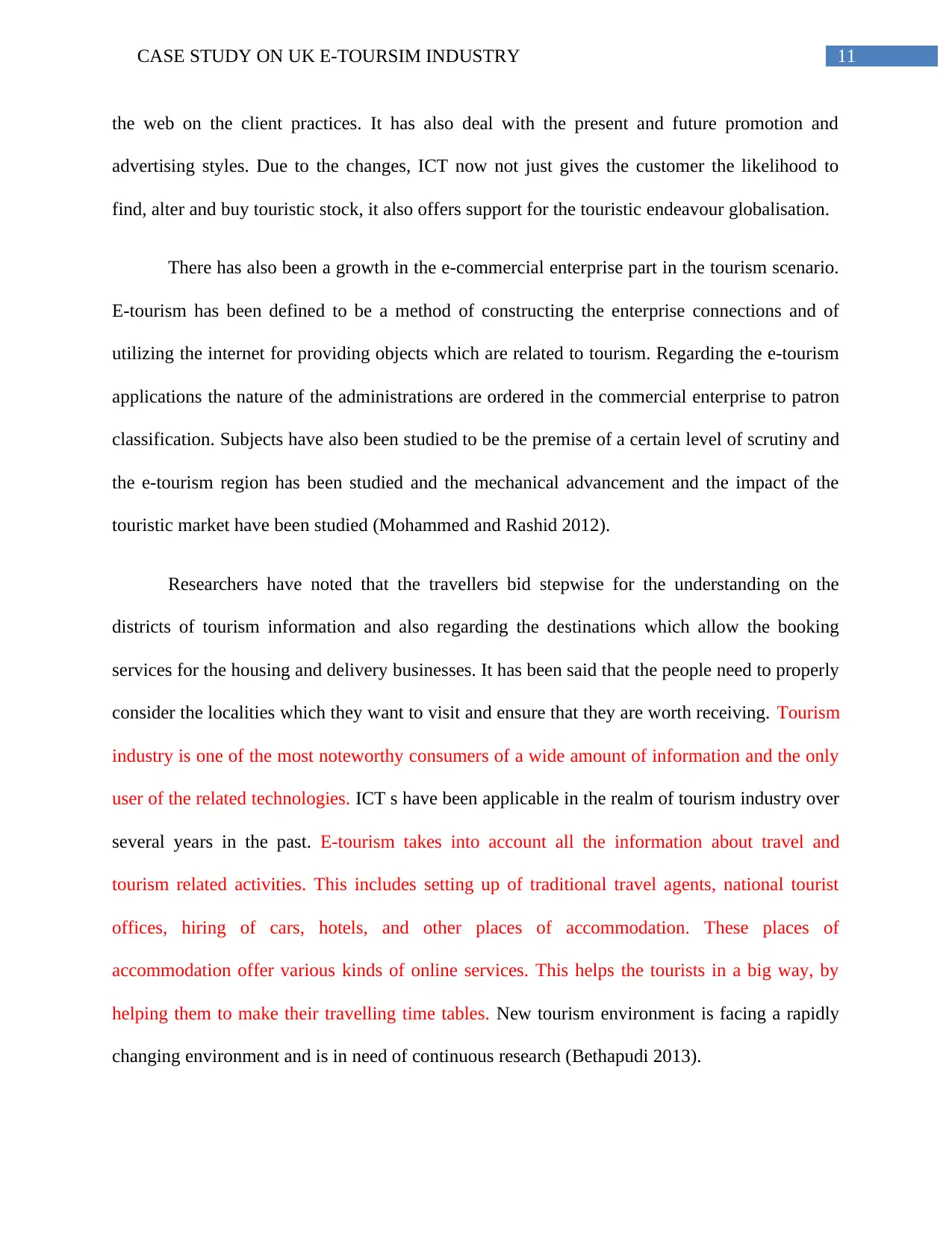
11CASE STUDY ON UK E-TOURSIM INDUSTRY
the web on the client practices. It has also deal with the present and future promotion and
advertising styles. Due to the changes, ICT now not just gives the customer the likelihood to
find, alter and buy touristic stock, it also offers support for the touristic endeavour globalisation.
There has also been a growth in the e-commercial enterprise part in the tourism scenario.
E-tourism has been defined to be a method of constructing the enterprise connections and of
utilizing the internet for providing objects which are related to tourism. Regarding the e-tourism
applications the nature of the administrations are ordered in the commercial enterprise to patron
classification. Subjects have also been studied to be the premise of a certain level of scrutiny and
the e-tourism region has been studied and the mechanical advancement and the impact of the
touristic market have been studied (Mohammed and Rashid 2012).
Researchers have noted that the travellers bid stepwise for the understanding on the
districts of tourism information and also regarding the destinations which allow the booking
services for the housing and delivery businesses. It has been said that the people need to properly
consider the localities which they want to visit and ensure that they are worth receiving. Tourism
industry is one of the most noteworthy consumers of a wide amount of information and the only
user of the related technologies. ICT s have been applicable in the realm of tourism industry over
several years in the past. E-tourism takes into account all the information about travel and
tourism related activities. This includes setting up of traditional travel agents, national tourist
offices, hiring of cars, hotels, and other places of accommodation. These places of
accommodation offer various kinds of online services. This helps the tourists in a big way, by
helping them to make their travelling time tables. New tourism environment is facing a rapidly
changing environment and is in need of continuous research (Bethapudi 2013).
the web on the client practices. It has also deal with the present and future promotion and
advertising styles. Due to the changes, ICT now not just gives the customer the likelihood to
find, alter and buy touristic stock, it also offers support for the touristic endeavour globalisation.
There has also been a growth in the e-commercial enterprise part in the tourism scenario.
E-tourism has been defined to be a method of constructing the enterprise connections and of
utilizing the internet for providing objects which are related to tourism. Regarding the e-tourism
applications the nature of the administrations are ordered in the commercial enterprise to patron
classification. Subjects have also been studied to be the premise of a certain level of scrutiny and
the e-tourism region has been studied and the mechanical advancement and the impact of the
touristic market have been studied (Mohammed and Rashid 2012).
Researchers have noted that the travellers bid stepwise for the understanding on the
districts of tourism information and also regarding the destinations which allow the booking
services for the housing and delivery businesses. It has been said that the people need to properly
consider the localities which they want to visit and ensure that they are worth receiving. Tourism
industry is one of the most noteworthy consumers of a wide amount of information and the only
user of the related technologies. ICT s have been applicable in the realm of tourism industry over
several years in the past. E-tourism takes into account all the information about travel and
tourism related activities. This includes setting up of traditional travel agents, national tourist
offices, hiring of cars, hotels, and other places of accommodation. These places of
accommodation offer various kinds of online services. This helps the tourists in a big way, by
helping them to make their travelling time tables. New tourism environment is facing a rapidly
changing environment and is in need of continuous research (Bethapudi 2013).
⊘ This is a preview!⊘
Do you want full access?
Subscribe today to unlock all pages.

Trusted by 1+ million students worldwide
1 out of 65
Related Documents
Your All-in-One AI-Powered Toolkit for Academic Success.
+13062052269
info@desklib.com
Available 24*7 on WhatsApp / Email
![[object Object]](/_next/static/media/star-bottom.7253800d.svg)
Unlock your academic potential
Copyright © 2020–2025 A2Z Services. All Rights Reserved. Developed and managed by ZUCOL.


